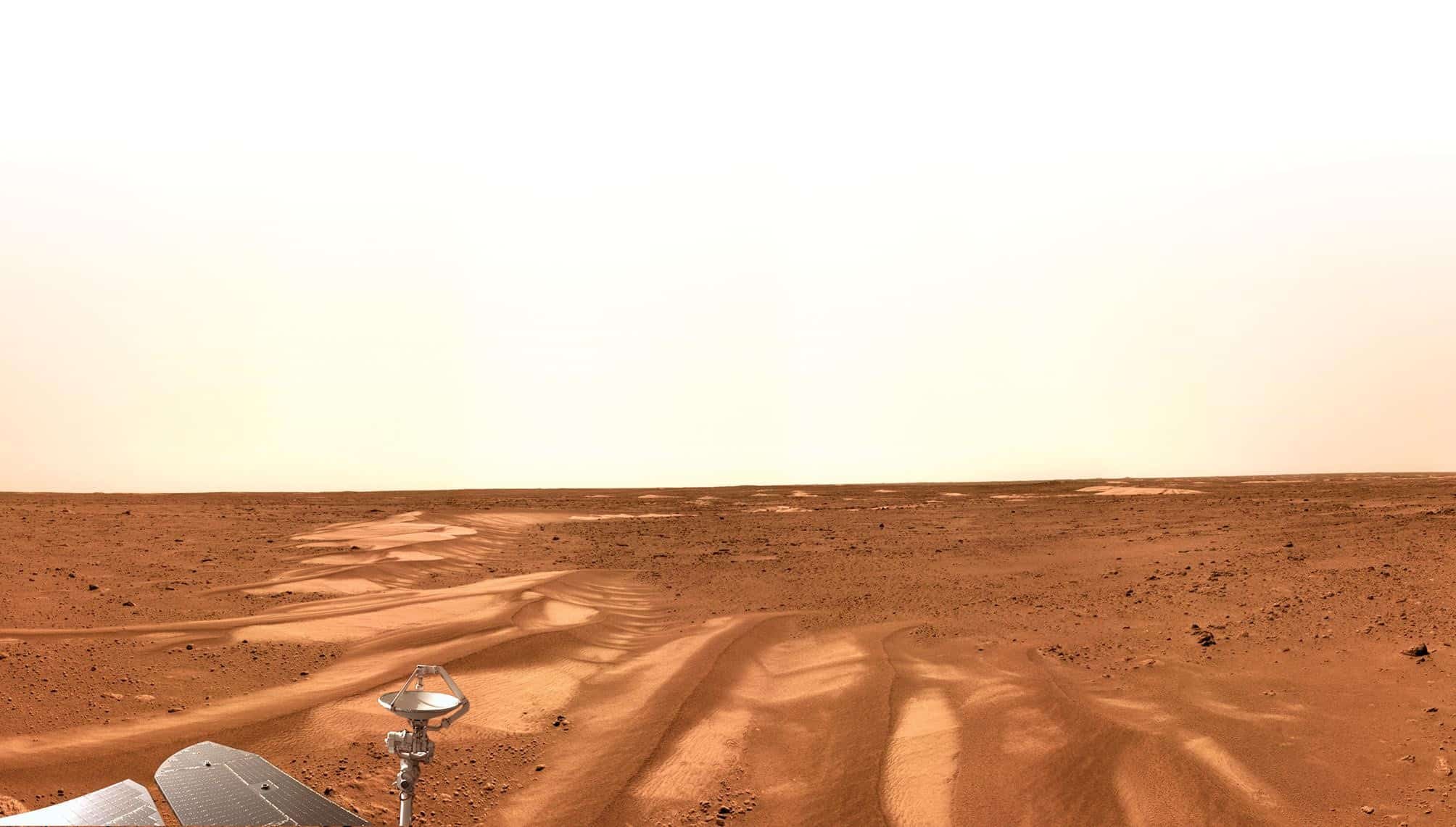 Intelligent Design
Intelligent Design
 Physical Sciences
Physical Sciences
Challenges to Terraforming Mars Highlight the Intelligent Design of Earth

Our colleague David Coppedge wrote earlier today on “Saturn’s Moon Titan as a Habitability Test.” While we’re on the subject, how about the habitability of Mars? Sven Bilén, Professor of Engineering Design, Electrical Engineering, and Aerospace Engineering at Penn State, works on “developing technologies to extend the human presence beyond Earth.” In a recent article, he discusses the engineering challenges people would face attempting to terraform Mars into a habitable planet for human colonization. When we consider the properties of the least hostile planetary surface in our solar system, outside of Earth, we find powerful testimony to the remarkable features of Earth as a planet that shelters and sustains not only humans, but millions of other species of life, in a diverse and interconnected ecosystem.
A short list of habitability requirements for humans includes the basics of air, water, and food. Earth has these in abundance; Mars, on the other hand, is a frozen, nearly airless, barren desert exposed to harsh solar radiation. Transforming Mars into a sustainable biological habitat would involve far more than bringing living organisms to Mars. I’ll examine several of these habitability basics, comparing Mars to our home planet, and look at the underlying conditions that led to Mars’s currently inhospitable environment.
Major Biohazards
One of the major biohazards on Mars comes from ultraviolet radiation emitted by our own sun:
…the present-day martian UV flux is…a constraint to an unadapted biota and will rapidly kill spacecraft-borne microbes not covered by a martian dust layer.1
Since Mars orbits about 50 percent farther from the sun than Earth, the intensity of solar radiation reaching Mars, compared to Earth, is reduced by over a factor of two. The reason the sun’s UV flux is sterilizing on Mars results from the thin Martian atmosphere, lacking any ozone layer.
But the Martian atmosphere is almost all carbon dioxide, with virtually no oxygen. And it’s very thin — only about 1% as dense as the Earth’s.
We’re all familiar with the fact that the sun emits UV radiation, but we may not realize just how much of that radiation is blocked by Earth’s atmosphere. The amount that reaches Earth’s surface is a minute fraction of the UV flux emitted by the sun. The shortest and most dangerous UV wavelengths are blocked in the upper atmosphere of Earth, primarily by ozone (O3). Biological studies of the lethality of UV radiation have identified certain wavelengths, in the spectral range known as UVC, that most readily disrupt cellular DNA.
UV radiation at 250 nm showed the highest cell killing ability, with a median lethal dose (LD50) of 120 mJ/cm2….DNA, which maximally absorbs radiation at wavelengths of 245–290 nm, is one of the main cellular targets of UV radiations. Owing to its wavelength, which is within the absorption peak of DNA, UVC (200–280 nm) is the most proficient in induction of DNA damage.2
Note that due to absorption in our atmosphere, primarily by the stratospheric ozone layer, dangerous UVC radiation cannot reach the surface of the Earth. Life on Earth exists under a protective covering that is completely absent on Mars. We can estimate just how harsh the radiation climate is on Mars by using solar irradiance data measured at Earth’s orbit and adjusting the intensity for Mars, orbiting at an average distance 1.52 times farther from the sun.
The solar irradiance at Earth’s orbit is roughly 1000 mW/m2-nm over the range of 245–290 nm. For this UV wavelength range, studies show that the median lethal dose3 is about 220 mJ/cm2, from which I calculate the time for exposed cells to absorb a lethal dose to be about one minute on Earth, if our atmosphere didn’t protect us, and just under two minutes at the surface of Mars.
Morbidity on Mars
The thin, predominantly CO2 atmosphere of Mars does not offer any protection from UV radiation in the wavelength range most detrimental to cellular life. This morbid result corroborates what I had read in one of the astronomy texts I used to teach from, that an unprotected person on Mars would suffer a lethal dose of UV radiation in a shorter time than it would take to die from lack of oxygen.
Professor Bilén critiques various proposals for beefing up Mars’s atmospheric density. Using nuclear explosions to trigger volcanic eruptions and the release of trapped gases earns the comment, “that scheme is a bit harebrained,” due to the obvious detriment to habitability posed by nuclear radioactive fallout. His “better idea” is “Redirecting water-rich comets and asteroids to crash into Mars.” Not a few such bombardments would be needed, however, and not without enormous effort and cost.
But there’s a bigger problem, and it’s connected with the reason Mars’s atmosphere is so thin in the first place. Simply attempting to replenish Mars’s atmosphere without also addressing the planet’s conditions that resulted in its loss in the first place would be like trying to pump up a flat tire without first fixing the leak.
Attempting to “reboot” Mars’s habitability by somehow supplying it with a denser atmosphere would be a monumental project and only a transient solution, since the conditions leading to Mars’s original loss of atmosphere still persist today. Two conditions are implicated in the atmospheric loss of Mars, and both are related to Mars’s small size (half of Earth’s diameter) and its small mass (1/10th Earth’s mass).
How long a planet takes to cool by thermal radiation loss into space is inversely proportional to its surface area and proportional to its thermal mass. Mars’s surface area is about 4 times less than Earth’s, but its thermal mass is nearly 10 times less than Earth’s, suggesting that Mars’s interior would cool 2.5 times faster than Earth’s. Other factors, such as the percentage of radioactive elements within its core, also determine how long a planet’s core could remain hot.
Earth’s average density is 40 percent higher than the density of Mars, leading scientists to believe that Earth has a significantly higher abundance of heavy, radioactive elements. The cumulative energy released from the radioactive decay of these elements has contributed to keeping Earth’s core hot enough to sustain tectonic activity and a protective magnetic field.4
Mars’ atmospheric loss is attributable to its lack of a protective magnetic field.
Turning off the magnetic field allowed the Sun’s wind of energetic particles and extreme ultraviolet light to strip away the atmosphere — and with it went vast amounts of water. The end product was today’s thin, cold atmosphere.
Irremediable Problems
The lack of a magnetic field on Mars compounds the problem of its smaller mass, meaning a lower surface gravity, which weakens its ability to gravitationally hold onto atmospheric gases. It would of course be an unrealistic goal to attempt to terraform Mars by boosting its mass by a factor of 10 to bring it in line with Earth’s mass. So, Mars’s low mass, resulting in lower gravity and a cooled-off core without a planetary magnetic field, are irremediable problems.
Earth’s magnetic field, sustained by a core that is still as hot as the surface of the sun, functions as an essential magnetic shield, protecting our atmosphere from sputtering away through the constant bombardment of cosmic rays and the solar wind. Mars suffered a different fate due to its different initial conditions.
When a planet cools, its tectonic activity also ceases. Without tectonic activity (especially volcanic eruptions), Mars loses an important process of replenishing atmospheric gases.
Additional challenges facing any attempt to terraform Mars for human habitation include water and arable soil. In a subsequent article, I’ll examine these necessary conditions to sustain life, revealing further evidence of design on planet Earth.
Notes
- Cockell CS, Catling DC, Davis WL, Snook K, Kepner RL, Lee P, McKay CP. “The ultraviolet environment of Mars: biological implications past, present, and future,” Icarus. 2000 Aug; 146(2):343-59. doi: 10.1006.
- R. Masuma, et al., “Effects of UV wavelength on cell damages caused by UV irradiation in PC12 cells,” Journal of Photochemistry and Photobiology B: Biology, Vol. 125, (August 5, 2013), pp. 202-208. https://www.sciencedirect.com/science/article/abs/pii/S1011134413001243?via%3Dihub.
- R. Masuma, et al, https://www.sciencedirect.com/science/article/abs/pii/S1011134413001243?via%3Dihub.
- Hugh Ross, Improbable Planet: How Earth Became Humanity’s Home (Grand Rapids: Baker Books, 2016), p. 26.
